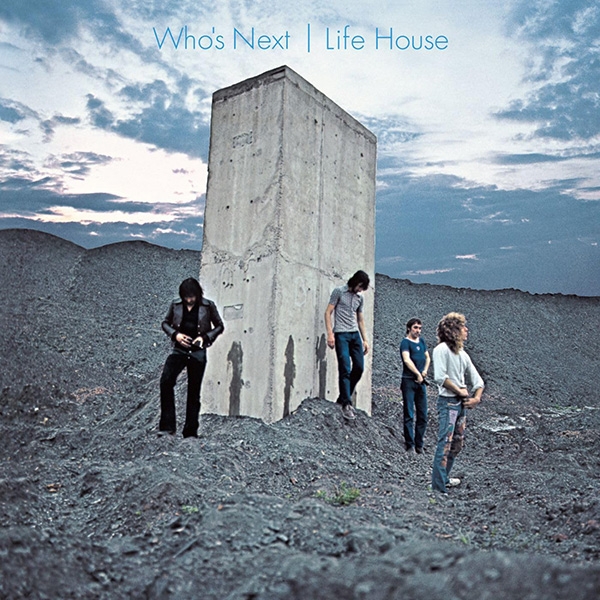| Columns Retired Columns & Blogs |
Found it on Amazon Music in Ultra HD....24/192.

Impossibly ambitious? Too many demands on the audience? Tommy done better? A final collapse before a glorious resurrection? 1971's Who's Next, which began life as a more-advanced-than-Tommy sci-fi rock opera called Life House (also called Lifehouse), is all that and more. All the elements of this oft-reissued opus have been remastered and reissued in several new configurations, the most complete being the Who's Next/Life House Super Deluxe Edition, which includes 10 CDs with 155 tracks sourced from the original tapes, 89 of them previously unreleased. That edition also includes demos, singles, studio sessions, and two complete Who's Next–era concerts, from London and San Francisco. A 100-page hardback book provides the visuals. For immersive audio fans, there's Blu-ray audio with new Atmos and 5.1 surround mixes of the original album. A 172-page Life House graphic novel is included for context. For superfans, there's a raft of tchotchkes including a pair of gig posters, two concert programs, four buttons, and a band photo with printed autographs.
After Tommy, Who guitarist and chief songwriter Pete Townshend began work on another, even grander multimedia concept album. Townshend told Billboard in 2003, "In Tommy I used the device of a child being smitten deaf, dumb, and blind by witnessing a violent trauma. In Life House I used a similar device again: an individual plunged into a life of virtual reality fed by something like the internet, suspended in a kind of parallel life in virtual animation, experiencing totally phony lifestyles."
According to the original concept, humanity's salvation lay in devising a single musical note that would trigger unity in the face of society's impending doom. Things began to unspool when the idea of making a film and eliciting audience interaction became part of the plan. Music for Life House was recorded in New York at The Record Plant and later re-recorded at Olympic Studios in London with Glyn Johns in charge. Concerts at London's Young Vic Theatre at which fans were expected to give their opinions failed when the crowd just wanted to hear the band play. The project's overreach eventually had Townshend teetering on the verge of a nervous breakdown.
Once the Life House concept was abandoned, Glyn Johns encouraged the band to release the best of the Life House songs as a single album. Songs from Life House appeared on later Who albums including Odds & Sods and Hooligans. A complete version of the project, titled Lifehouse Chronicles, was released as 6-CD box set in 2000 on Townshend's Eel Pie label.
What's most impressive about the exhaustively completist Super Deluxe reissue, as well as the separate, blue 180gm vinyl-LP reissue of the original album, is the improved sound. Most easily heard on the LP versions of "Behind Blue Eyes," "Bargain," and "This Song Is Over," the midrange dynamics now seem richer and the bass response a touch more active. Keith Moon's more disciplined drumming (in theory because of Johns's no-nonsense presence) sounds more vital and alive. Also on the sonics front, the two concerts on the Super Deluxe set are beautifully clear and detailed, a rarity for 50-year-old tape sources.
The five CDs of extra tracks here are far more valuable than the extra material in most reissues in providing an outline of how the grandiose Life House was winnowed down to Who's Next. A telling example is the creative journey of "Baba O'Riley." The basic musical structure came from a demo that has Townshend joyously exploring the then-new VCS3 and ARP synthesizers for more than 13 minutes. A second demo, trimmed to 7:48, has Roger Daltrey singing words imported from another song meant for Life House, "Teenage Wasteland." Yet another version, labeled "First Editing Demo" (7:53), with different guitar tones and without the final drum tracks, is much closer to the released version. In the San Francisco show, "Baba O'Riley" has John Entwistle's bass guitar unusually forward in the mix.
Album cover images are now considered a consequential artform, and few have been as impactful as the peed-on concrete monolith from South Yorkshire that graces the Who's Next cover. According to Andrew Neill and Matthew Kent in Anyway Anyhow Anywhere: The Complete Chronicle of The Who 1958-1978, an alternative suggestion was a shot of an extra-large naked woman, her genitalia covered by The Who's faces.
The plethora of extra material on the Super Deluxe reissue of Who's Next/Life House is a fascinating window into the creative process. In that 2003 Billboard interview, Townshend reflects on the experience of turning Life House into the concentrated Who's Next: "I was really proud of it. Proud of the way it sounded. ... I knew that there was a bit of depth there if you wanted to look." This new collection more than confirms that.—Robert Baird

Found it on Amazon Music in Ultra HD....24/192.
